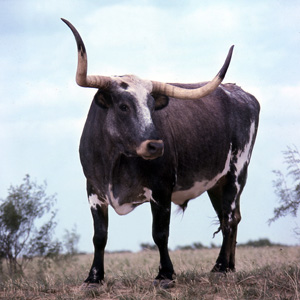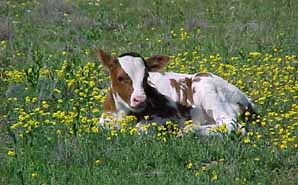Texas Longhorns in State Parks
State Parks with Texas Longhorns:
- Copper Breaks State Park
- Lyndon B. Johnson State Park & Historic Site
- Palo Duro Canyon State Park
- San Angelo State Park
Texas longhorn legacy
Travelers crossing Texas in the early 1800s told stories of seeing many wild cattle, often thought to be native species. Early Texans looked on free-range cattle as game, much like deer and buffalo, albeit very wild and even more difficult to hunt.
First known as “Texas cattle,” and later, “Texas Longhorns,” the animals had spread over a wide area by the time Texas won its independence from Mexico in 1836. They ranged from the Red River to the Rio Grande, east to the Louisiana line and west to the upper breaks of the Brazos River. These early longhorns, almost completely wild, continued to roam Texas until the end of the Civil War.
The great cattle drives
After the Civil War, Texas veterans returned home to a poor state and devastated economy. Fortunately, they had access to a marketable commodity—millions of wild longhorn cattle.
Transporting cattle north to beef-starved markets presented a challenge. Thus began overland cattle drives via famous cattle trails such as the Western, Chisholm and Goodnight-Loving to the great rail yards in Kansas, Wyoming and other northern states.
The end of an era
By the early 1900s, ranchers saw the longhorn as a less desirable breed of cattle. Rail access improved, barbed wire closed the open range, trail drives become memories, and ranchers no longer transported beef cattle to faraway markets. Ranchers favored European breeds that yielded more beef per animal, and the number of longhorns fell.
Texas conservation efforts
Western writer J. Frank Dobie recognized the Texas Longhorn decline in the early 1920s. He felt it was important to preserve the breed that held such a significant place in Texas history. With help from businessman Sid Richardson and rancher Graves Peeler, Dobie procured a herd of typical longhorns. They donated the animals to the Texas Parks Board in 1941 as the state herd. The board placed the herd at Lake Corpus Christi State Park near Mathis. The search continued for more of the scarce longhorns. In 1942, the board placed a second herd at Lake Brownwood State Park.
As these sites were not ideal, the Texas State Parks Board began looking for a permanent home for the herd. The board chose Fort Griffin State Park (now the Texas Historical Commission’s Fort Griffin State Historic Site) as the longhorns’ permanent home in 1948.
The Texas Legislature recognized the herd with Senate Concurrent Resolution No. 79 on May 17, 1969.
Longhorns today
The Historical Commission and Texas State Parks now jointly manage the Official State of Texas Longhorn Herd. Members of the herd live at San Angelo, Copper Breaks, Palo Duro Canyon and Lyndon B. Johnson state parks.
Find more information on the Official State Longhorn Herd on the Fort Griffin's Texas Historical Commission website.


